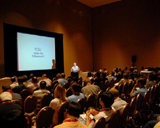Communication in healing
The role of communication in healthcare
“My doctor hardly lets me speak, nor does he listen to me when I do.”
How many times we have heard this complaint from patients! An old doctor friend, well into his seventies now but still active as a general practitioner, once told me:
“More than 75% of my treatment is in patient communication. Hardly 25% goes to the medicines I prescribe.”
With the pace of living shooting up like a barometer gone berserk, interpersonal relations are being given the go by. When was it that we last had a heart to heart talk with anybody?
The classic image of a doctor is that of a patient, calm, wise, middle-aged man who is physician-cum-confidante, who advises your son on which subjects to choose at college, asks how your grandfather is doing at the village home, and gives you tips on how to rid your dog of fleas. This friend-philosopher-guide image has been battered almost beyond recognition now, thanks to the majority of doctors switching to the fast track. After all, time is money, and money to many is everything.
The body mechanic
Today’s doctor is fast becoming a body mechanic (or a mind mechanic if he is a psychiatrist) whose patients arrive on a conveyer belt, are treated as they pass by and go on, heavier in heart and lighter in pocket. There is no human touch, there is no hand on the shoulder, a pat on the back, the piercing gaze and embracing smile that make your aches vanish. An old friend of mine had been going to the same doctor for decades and would steadfastly refuse to see anybody else, including specialists. He once told me that he had gone to see his doctor to seek some remedy for a recurring gout problem. At the clinic, they met as old friends, exchanged news and pleasantries and generally had a chat.
“It was only when I got home that I realised I had not mentioned my gout at all!”
If a doctor can make you forget pain just by his presence, need we say more about his efficiency as a care-giver?
To be fair, we must also consider the other side. There are several patients who are too impatient to understand their illnesses. To them the doctor’s duty is surely to cure. They will smoke, drink, eat indiscriminately but when they fall ill, they expect the doctor to wave a magic wand and put them back on the road with a few pills and injections. They do not want to listen to any doctor’s advice about their lifestyles, nor do they have time to consider such petty matters.
“If I have to do all the work then what is the doctor for? Why am I paying him if he cannot put me right?”
There are people like this, but it is still the doctor’s duty to handle them too, in the best manner possible, not just put his hands up and say
“If he does not want to help himself, then what can I do?”
If the doctor is also a communicator, he can make the patient listen to him, even sit up and take notice.
Time management
The first contact between patient and health provider is at the clinic or OPD. Here, many doctors tend to brush off patients, especially those ‘that eat my head,’ without giving them an uninterrupted hearing. If there is a crowd of patients, it is natural that the doctor will tend to hurry rather than reschedule non-acute or less urgent cases. As a result, the patient feels shortchanged. Several doctors allocate a specific time to each one but it may not always be advisable to tell the patient so, for he may labour under the impression that he has a limited time and will cram all his problems into as short a time as possible. Here, the tact and diplomacy of the doctor comes into play. Even if he politely tells the patient that he is interested in knowing more, but would like to do so at leisure, and not when rushed, so why not fix an appointment for Thursday when he is relatively free...? The patient normally understands and is grateful to the doctor for being frank and honest.
There are several doctors who do not bother to explain the nature and cause of the illness to the patient either because
a) they do not know
b) they do know but might feel their importance and position undermined if the patient knows too
c) they do not think the patient will understand
d) they do not want to ‘waste their time’.
In these days of information boom, a patient cannot be kept in the dark for long. Better that he knows from his doctor than from another source.
Communication methods
Essentially, communication takes three forms — the spoken word, written word or through gestures and facial expressions. While a kind word is definitely recognized, a compassionate smile or pat on the back is immediately appreciated (unless it is not genuine). Such gestures go a long way in boosting the morale of the patient. The written word is generally the least effective, as it is impersonal and devoid of human touch. Even so, cheerful posters and pithy sayings do brighten up the waiting area. It is better to see a flower or a waterfall than a drab wall or preposterous advertisement for a pain killer. Some doctors distribute free information literature on some aspects of certain diseases or particular line of treatment. This definitely has its uses, saves time, improves the knowledge of the patient, but in the final analysis, cannot compare with an across the table conversation or gentle hand on the shoulder.
For communication to be effective, it has to be genuine. Contrived, rehearsed expressions, the fixed smile, cocked head and imported accent may all have theatrical value but are hardly of any use in communicating with the patient. What the patient wants is sympathy and relief. He/she is intelligent enough to discern the genuine from the fake. Therefore, if the physician has a genuine desire that the patient should get well, it will reflect in his bearing and speech. Response to treatment will also be enhanced, since the patient’s faith in his doctor is safeguarded because he is satisfied with the services of the doctor.
If you are a doctor, it would be a good idea to train your receptionist to smile, interact with patients more and engage them in pleasant conversation while they wait. This not only helps the patient overcome the tedium of waiting but also puts him in a relaxed frame of mind, so more receptive and responsive to treatment.
In the hospital
When the patient is hospitalized, he is in an atmosphere totally different from what he is used to. The pain he endures, the anxiety on the faces of relatives, the uncertainty of what he will undergo at hospital, all these contribute to an unstable state of mind. Here, he clings to a receptionist’s smile, a kind word from a nurse, even the tuneless song of a ward boy as he is wheeled to his bed or elsewhere.
I had the privilege of working under a hospital administrator who was very fond of telling his staff:
“There is only one job in this hospital — to provide a service to the patient. It does not matter whether you are a doctor, nurse, ward boy, accountant, telephone operator, technician or whatever. What all of you do in some way — directly or indirectly — relates to patient care.”
He would go on to give examples of how, in being quick and accurate, the billing clerk could help the patient go home sooner, at the same time making the bed free so that another patient who required the bed did not have to wait. The receptionist who was courteous and helpful, the telephone operator who never displayed any irritation, the sweeper who kept the premises clean, they were all serving patients.
Since every hospital employee might come into contact with patients, their relatives, outsiders and visitors, he even devised special workshops for various categories of staff to improve their communication skills. It was his contention that you could be polite, firm and effective at the same time. It used to be a treat to stand by and observe the patience with which the security guards (who had received the training) would explain why visiting hours had been specified, and would everybody kindly cooperate with the hospital in helping achieve a faster recovery for the patient etc.? Or admonish them in gentle tones, as one would a child:
“You would not like this patient to stay here longer, would you? Then let him rest now, and come during visiting hours. If he keeps on getting visitors all the time, when is he going to get rest?”
Training and motivation
Needless to say, as long as this administrator was around, the hospital flourished, but after his departure, it gradually went to seed. Nevertheless, many of us retained some of his wisdom and became more effective in communication and better people overall.
“The doctors are good but the nursing is horrible,” or “people don’t talk to you properly,” or “don’t they teach the technicians how to talk to patients?” are all expressions that are commonly heard around hospitals. Is this a fact of life and is it still possible to find places where the walls do not reverberate with the disgruntled mutterings of patients and their kin? All it takes is a smile, a few kind words and a genuine desire to help the patient recover soon.
Unfortunately, induction, in-house training and holding of workshops to hone various employee skills do not fall within management priorities at most hospitals. This is illogical, counter-productive and harms patient satisfaction and goodwill. Time and energy spent on training staff at effective communication is of much more value than a hundred hoardings or other forms of publicity.
But when will our health administrators wake up?
Mr. C. Ravindranath is himself a dedicated health administrator who has been working at various hospitals in India.
Share with us (Comments,contributions,opinions)
When reproducing this feature, please credit NAMAH,and give the byline. Please send us cuttings.





